In 2009, Ulysse Nardin introduced Moonstruck, a watch that was much more than a timepiece to tell the time. Its functionality was based upon an idea that previous owner Rolf Schnyder had for a watch with a tidal display that worked properly regardless of the geographical location of its owner; existing tidal watches to that point were only able to show the tides in certain geographical locations.
Schnyder collaborated with Ludwig Oechslin to see if there might be a way to make such a display work for every location on the entire planet.
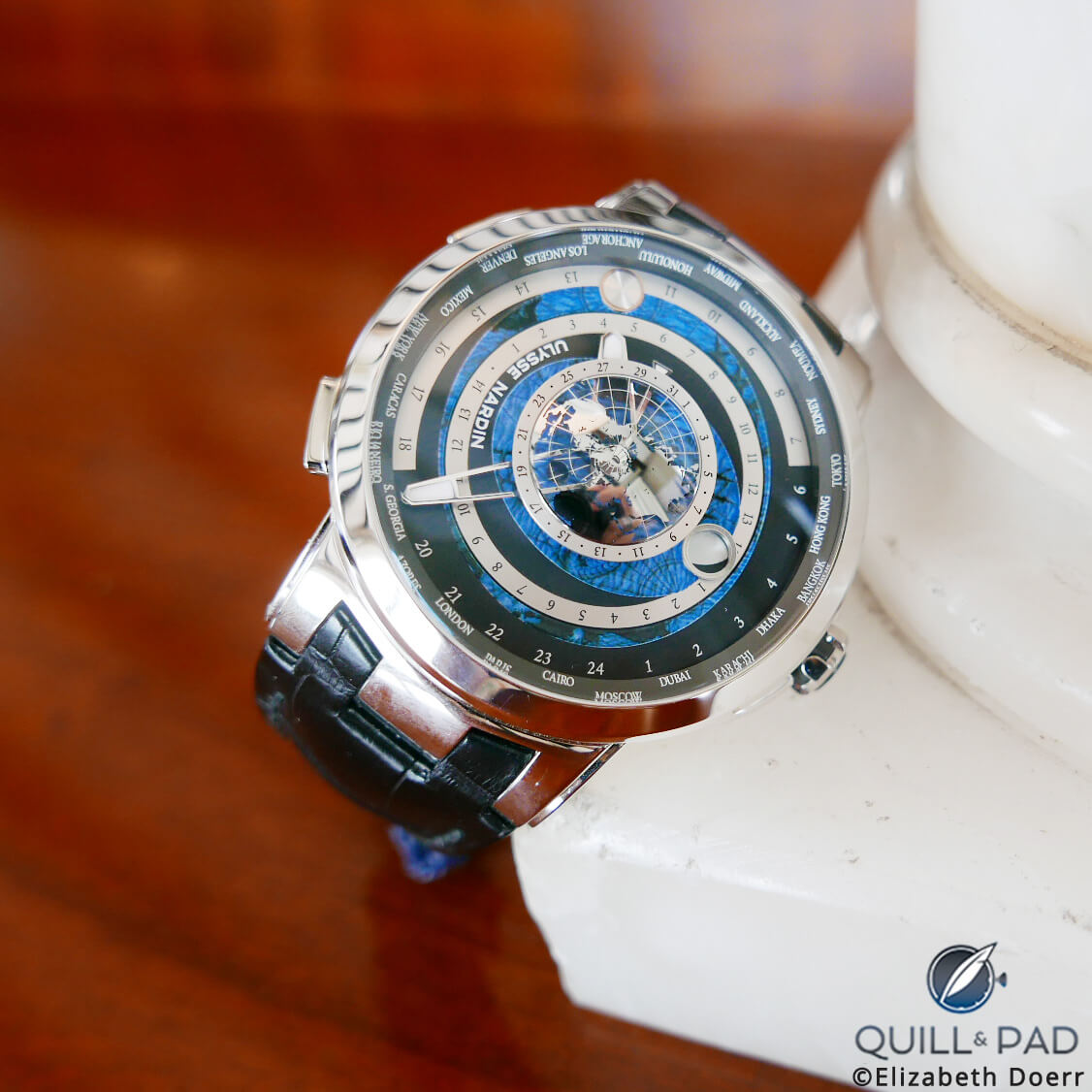
Ulysse Nardin Executive Moonstruck Worldtimer
The initial premise of the Moonstruck has now been extended to include world time. But before we jump into that, let’s briefly refresh the watch’s astronomical functions, functions that allow it to display the earth’s tides at a glance.
The Moonstruck tides
The tides, as Oechslin well knew, are not only caused by gravitational effects of the moon, but also by those of the sun.
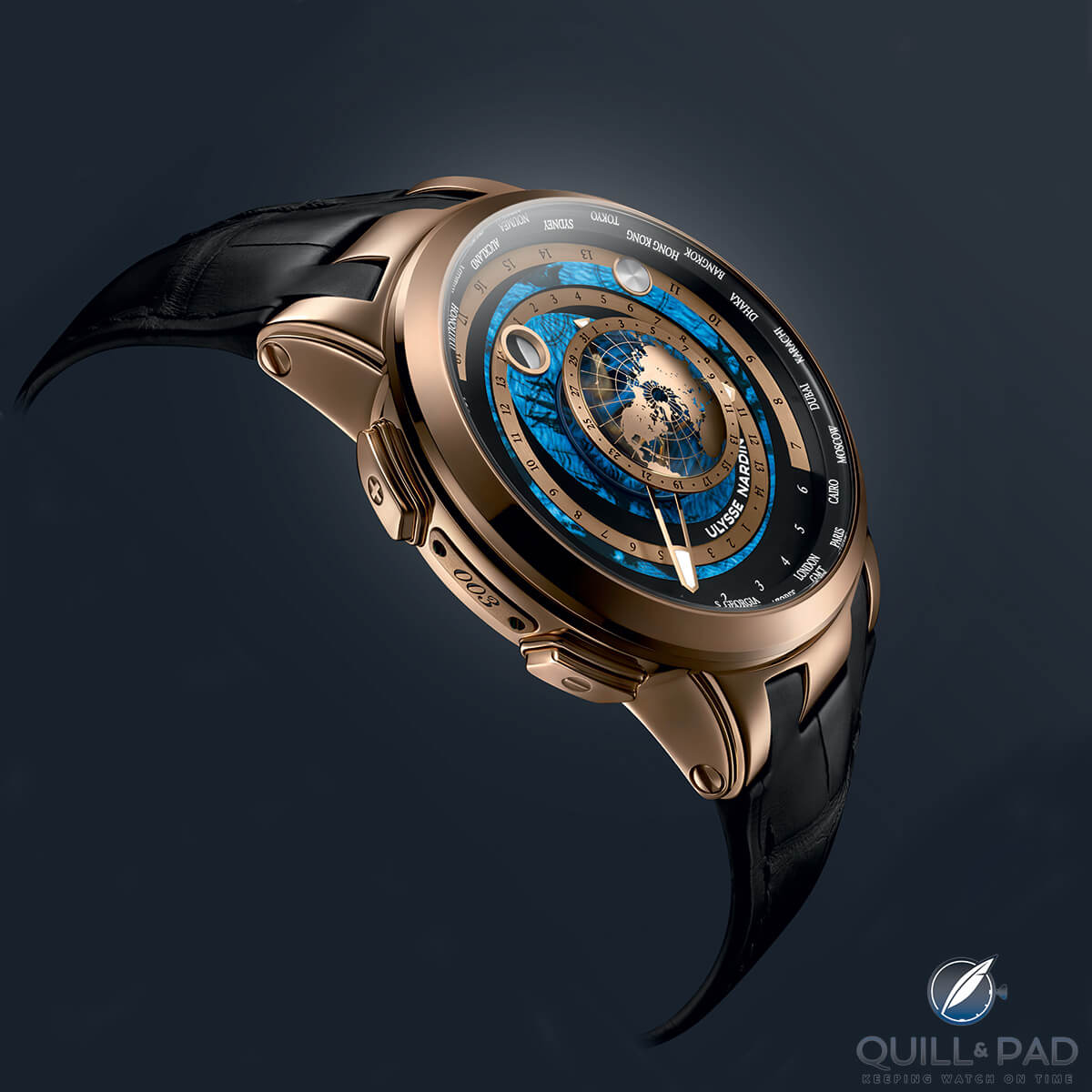
Ulysse Nardin Executive Moonstruck Worldtimer in red gold
The starring role on the Moonstruck’s geocentric dial is however occupied by the earth, which is now artistically displayed as it would be seen if one were looking down from above the North Pole. The earth does not revolve on the dial; instead, two disks as they would be seen from the Northern Hemisphere do the revolving.
This more simplified version of the Moonstruck now no longer visually concentrates on the tidal indication, but rather that which makes the tides possible: the moon’s orbit and the visible path of the sun in the sky as the earth revolves around it.
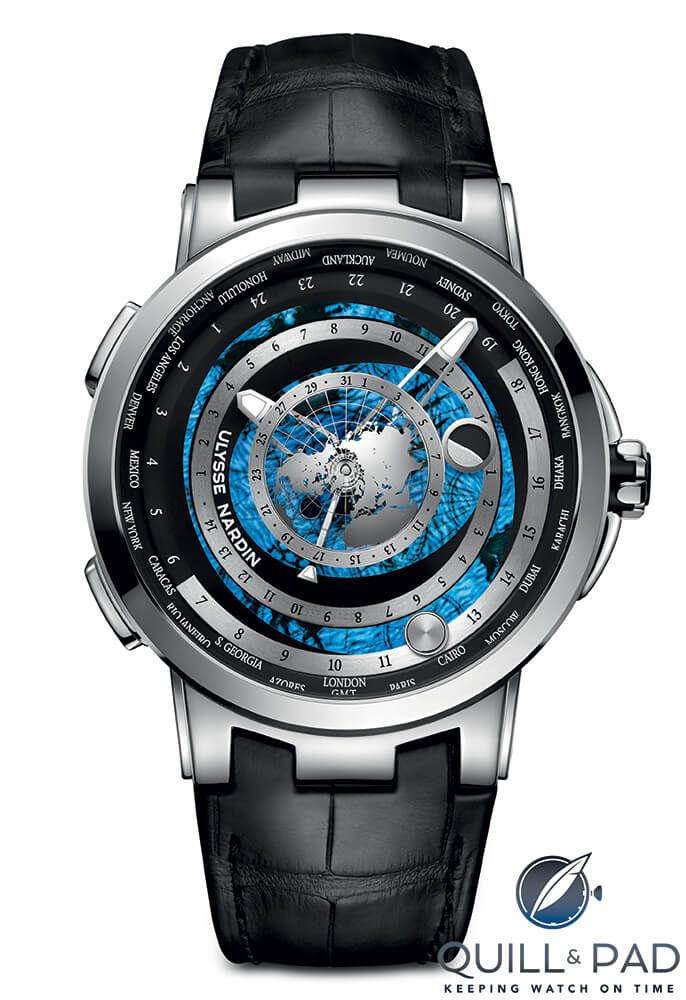
Ulysse Nardin Executive Moonstruck Worldtimer in platinum
The display showing the moon’s position comprises two stacked disks: the top disk is a circular cutaway to display the position, while the bottom one indicates the phase of the moon. The cutaway moves across the disk, going from completely dark (new moon) to completely colored (full moon) to illustrate the synodic month.
One of the really challenging things about moon phase displays on mechanical watches is accuracy since the synodic phase (period between two full moons) is so uneven: 29.5305881 days.
Most moon phase complications display more simplified, i.e. less accurate, phases of the moon, which means that they need manual correction by a full day every three years (or less) if the watch were to run continuously for this period. There are rare movements with a higher degree of precision thanks to a more complicated movement, and Caliber UN-106 powering the Moonstruck is one of them. It needs adjustment by one full day only once in about 40 years.
For the top eight most accurate moon phase displays in wristwatches, see The 8 Most Accurate Moon Phase Wristwatches Today.
“Moonstruck’s precision deviates by about 12 hours in 70 years,” Oechslin stated at the time of the original watch’s release. “Since the watch needs to go in for maintenance every five to ten years, thereby being reset, this deviation will probably never be discernible.”
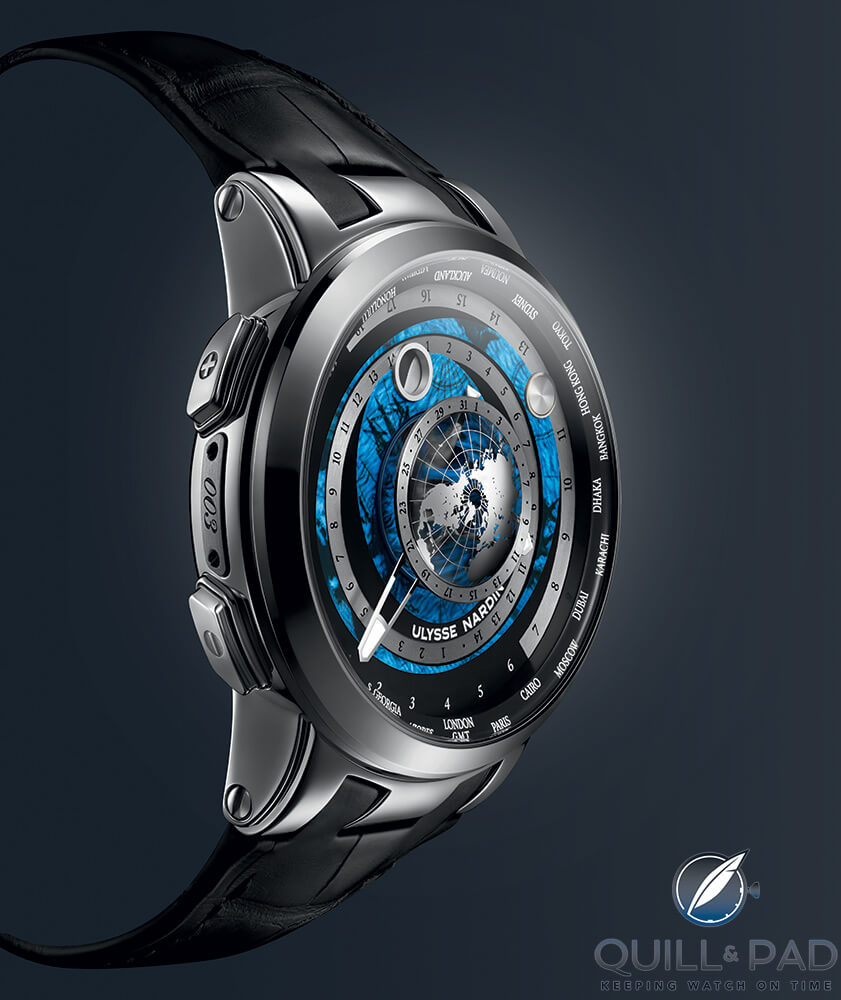
Ulysse Nardin Executive Moonstruck Worldtimer in platinum
Reading the tides using the oval-shaped “bulbs” on either side of the solar and lunar disks is not as complicated as it may seem. The dark blue sections surrounding the moon and sun disks depict the celestial bodies’ gravitational forces in a very straightforward way; in other words, it displays the ocean water displaced due to gravity.
Addition of world time
It would always have been possible to add world time to this watch, but the original edition with its gorgeously enameled dial seemed busy enough with its display of spring and neap tides, so Schnyder made the decision back then to have the watch just show a second time zone/24-hour display. It is also outfitted with Ulysse Nardin’s plus-minus GMT controls, which make traveling with a mechanical watch so practical and such a breeze to set and re-set. The time zones are easily mastered both backward and forward in one-hour increments (and still are on the new rendition of the Moonstruck).
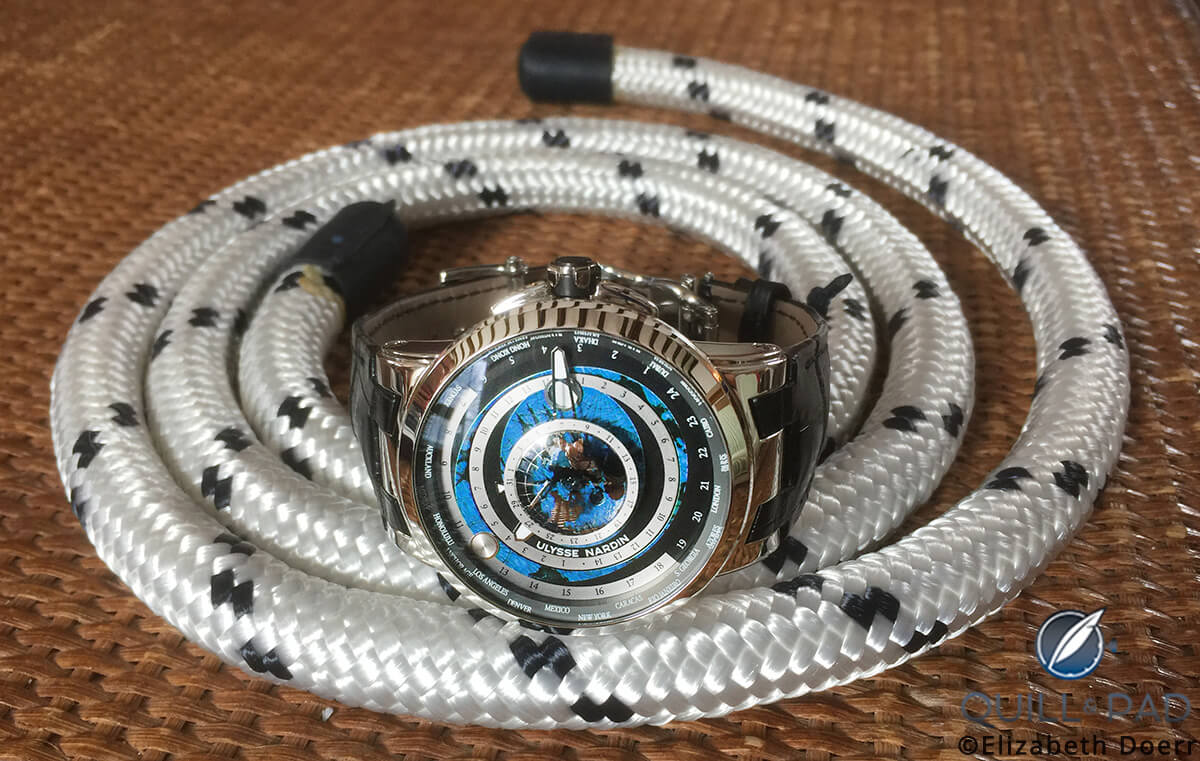
Ulysse Nardin Executive Moonstruck Worldtimer
The new arrangement of this Moonstruck’s dial made it possible to add world time without overloading the information shown by taking out the spring and neap tides: the 24 time zones are added to the map of the earth in the center of the dial, while a typical world time ring with reference cities has been added to the outermost part of the dial, just past a ring that displays 24 time zones and a day/night indicator (the freshly arranged 24-hour time or second time zone) carrying the sun disk.
Working our way in, we encounter the moon phases (as described above) and then the date.

Ulysse Nardin Executive Moonstruck Worldtimer in red gold
The time is very discretely shown by two hands poking out from behind the earth with luminous tips making it easy to read the time in adverse lighting conditions. A lume-tipped date hand points to numerals on the ring surrounding the fixed earth map to display the current date.
For more information, please visit www.ulysse-nardin.com/product/executive-moonstruck.
Quick Facts Ulysse Nardin Executive Moonstruck Worldtimer
Case: 46 mm, red gold or platinum, water-resistant to 100 meters
Movement: automatic Caliber UN-106 with silicon escapement and balance spring
Dial: lacquer, glass globe
Functions: hours, minutes; date, second time zone (indicated by “sun”), world time, day/night indication, displays of moon position and phase; sun position; tides
Limitation: 100 pieces
Price: $75,000 in red gold and €95,000 in platinum
Leave a Reply
Want to join the discussion?Feel free to contribute!

I must admit, I’m a “World Time” sucker. This takes it to a whole new level. Without a doubt someone could kill an entire morning at work playing with this. Unfortunately, at these prices, that’s not something my employer has to worry about!